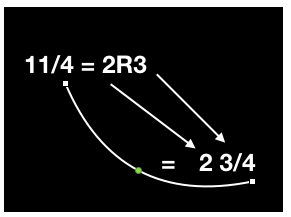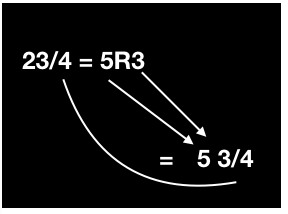Conversion of Improper fractions into mixed fractions helps to understand the result of algebraic problems in a better way. Improper fractions will have high-value numerators compared to denominators. Mixed fractions will have both whole numbers and a fraction. Examples of Converting Improper Fractions to Mixed Fractions are given here along with explanations and images. Read the concept and practice all the problems for a better understanding of the concept.
Example:
Suppose if you ordered a pizza of 6 slices and your friend ate it all and you didn’t get any of the pieces. So, you ordered another pizza and ate 1 slice from it. Hence the total pizza eaten is 7/6 parts.
It is the improper fraction as the numerator is greater than the denominator. Leftover pizzas, half-filled glasses of water are examples of mixed fractions.
How to Convert an Improper Fraction Into a Mixed Number?
We are providing the steps to convert an improper fraction into a mixed fraction in the following sections:
- In the first step, you have to divide the denominator with the numerator.
- Identify the divisor, quotient, and remainder.
- Now, write the mixed number in the form of remainder/divisor.
Converting Improper Fractions Into Mixed Fractions – Solved Examples
Example 1.
Convert the improper fraction \(\frac { 7 }{ 5 } \) into mixed fractions?
Solution:
Step 1. Divide the numerator by the denominator
Start converting by writing the improper fraction. Divide the numerator value by the denominator value and include the remainder. Suppose that you need to turn the fraction of \(\frac { 7 }{ 5 } \) into a mixed number, We apply the division rule and divide the numerator 7 by denominator 5, in this way:
\(\frac { 7 }{ 5 } \) → \(\frac { 7 }{ 5 } \) = 1 R2
Step 2. Write the answer as a whole number
The highest number present at the left of the fraction is the whole number answer of the problem. In other words, we can justify writing the division problem without the remainder. In step 1, the answer is 1 R2, so we leave the remainder and write the whole part 1.
Step 3. Make the fraction from the original remainder and denominator:
Make use of the remainder from step 2 and put it in the numerator and use the denominator from the original improper fraction. Now, add the fraction next to the whole number and you will have the mixed number. In the above example, the remainder is 2, put 2 in the numerator and original denominator 5. Hence, the fraction is \(\frac { 2 }{ 5 } \). Now, put the fraction next to the whole number i.e., 1 \(\frac { 2 }{ 5 } \) which is a mixed fraction.
Example 2:
Convert the improper fraction \(\frac { 11 }{ 4 } \) into mixed fractions?
Solution:
To convert the improper fraction \(\frac { 11 }{ 4 } \) into a mixed fraction, we use the following steps:
1. Divide the denominator with numerator ⇒ \(\frac { 11 }{ 4 } \) = 2 and it gives the remainder as 3.
2. Write the result whole number 2, then write the remainder 3 in the numerator above the denominator value.
3. 2 \(\frac { 3 }{ 4 } \) is the mixed fraction for the improper fraction \(\frac { 11 }{ 4 } \).

Example 3:
Convert \(\frac { 10 }{ 3 } \) into a mixed fraction?
Solution:
To convert the improper fraction \(\frac { 10 }{ 3 } \) into a mixed fraction, we use the following steps:
1. Divide the denominator with numerator ⇒ \(\frac { 10 }{ 3 } \) and it gives the remainder as 1.
2. Write the result whole number 3, then write the remainder 1 in the numerator above the denominator value.
3. 3 \(\frac { 1 }{ 3 } \) is the mixed fraction for the improper fraction \(\frac { 10 }{ 3 } \).

Example 4:
Convert \(\frac { 23 }{ 4 } \) into a mixed fraction?
Solution:
To convert the improper fraction \(\frac { 23 }{ 4 } \) into a mixed fraction, we use the following steps:
1. Divide the denominator with numerator ⇒ \(\frac { 23 }{ 4 } \) and it gives the remainder as 3.
2. Write the result whole number 5, then write the remainder 3 in the numerator above the denominator value.
3. 5 \(\frac { 3 }{ 4 } \) is the mixed fraction for the improper fraction \(\frac { 23 }{ 4 } \).

Example 5:
Convert the improper fraction \(\frac { 115 }{ 6 } \) into a mixed fraction?
Solution:
To convert the improper fraction \(\frac { 115 }{ 6 } \) into a mixed fraction, we use the following steps:
1. Divide the denominator with numerator ⇒ \(\frac { 115 }{ 6 } \) and it gives the remainder as 1.
2. Write the result whole number 19, then write the remainder 1 in the numerator above the denominator value.
3. 19 \(\frac { 1 }{ 6 } \) is the mixed fraction for the improper fraction \(\frac { 115 }{ 6 } \)

FAQs on Improper Fraction to Mixed Fraction Conversion
1. How to change the improper fraction into a mixed fraction?
1. Divide the numerator value by the denominator value.
2. Use the quotient value as the whole number.
3. Now, use the remainder as the numerator of the proper fraction.
2. What is 7/4 as a mixed fraction?
7/4 can be written as 1 ¾ in the mixed fraction.
3. What is the rule for mixed fractions?
Step 1: Multiply the denominator with the whole number of the mixed fraction.
Step 2: Add the numerator to the product received from step 1.
Step 3: Finally, write the improper fraction with the sum obtained from step 2 in the numerator/denominator form.